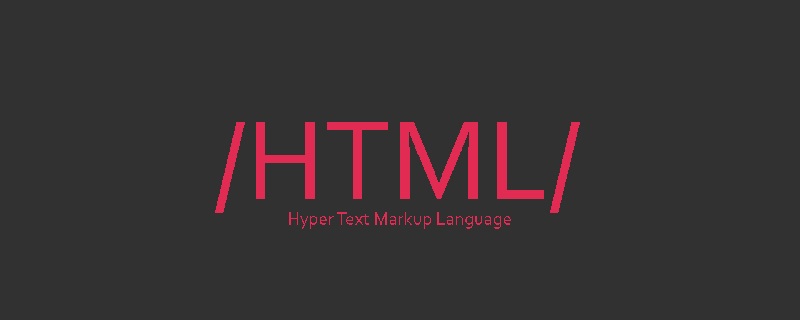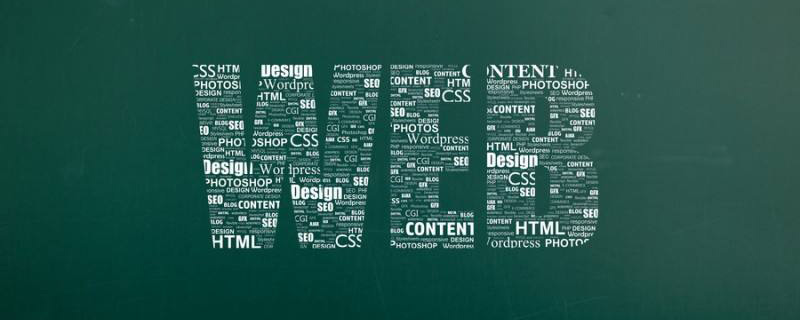 Web Front-end
Web Front-end CSS Tutorial
CSS Tutorial Detailed introduction to learning common knowledge points of web front-end
Detailed introduction to learning common knowledge points of web front-end1. Common block-level elements Inline elements
p - the most commonly used block-level elements
dl - block-level elements used with dt-dd
form - interactive form
h1 -h6- large Title
hr - horizontal separator line
ol - ordered list
p - paragraph
ul - unordered list
fieldset - form field set
colgroup-col - form column grouping element
table-tr- td Tables and rows - cells
pre - formatted text
a - hyperlink (anchor)
br - line break
i - italics
em - emphasis
img - picture
input - input box
label - form label
span - commonly used inline container, defining blocks within text
strong - bold emphasis
sub - subscript
sup - superscript
textarea - multi-line text input box
u - Underline
Select - Project selection
2. Several conditions for realizing three points of text
text-overflowAttribute is only: whether to display an omission mark when the text overflows, and does not have other styles Attribute definition, to achieve the effect of producing an ellipse when overflowing, you need to define:
1. Container width: width: value; (px, %, both are acceptable)
2. Force the text to be displayed in one line: white- space:nowrap;
3. Overflow content is hidden: overflow: hidden;
4. Overflow text displays ellipsis: text-overflow: ellipsis;
Note: It must be a single line of text to set the overflow of this article! ! !
IE6+; chrome1.0+; safari3.1+ (firefox, opera are not supported yet)
3. Several conditions for vertical centering
To set an element to be vertically centered in a container, you must change the default display The attribute value is inline-block;
and the sibling element (ruler) is added (the style of the sibling element [ruler] is set to vertical-align:middle;width:0;height:100%;display:inline -block;).
Three conditions:
1: text-align:center must be added to the container (parent element);
2: The current element must be converted into an inline block element (display:inline-block;) and then added Add vertical-align:middle to the current element;
3: Add the same-level element span after the current element (without carriage return); and perform vertical-align:middle;width:0;height:100%; on the span; display:inline-block
4. Replacement elements and non-replacement elements
Replacement elements and non-replacement elements
a) Replacement elements: The browser determines the specific display content of the element based on its tags and attributes. For example: the browser will read the image information and display it based on the value of the src attribute of the tag, but if you view the (x)html code, you cannot see the actual content of the image; the type of the tag Properties to determine whether to display input boxes, radio buttons, etc. (x)
, ,
The replacement element generates a box in its display, which is why some inline elements (img, input) can set the width and height.
b) Non-replaceable elements (non-replaceable elements): (x) Most elements of html are non-replaceable elements, that is, their content is directly displayed to the user (such as a browser).
5. What is a sprite? What are the advantages?
Image integration, integrate small single background images into one large background image.
Advantages of image integration: 1) Reduce the number of requests to the server through image integration, thereby improving the page loading speed. 2) Reduce the size of pictures by integrating them.
6. What is css cascadingstyle sheet? How is the priority algorithm calculated?
a. The priority order of importance and source from low to high is:
1) Browser default style
2) class/id.....selector weight
3) Interline Style
4) Inline or external (writing order)
5) !important The highest
7. The difference between display:none and visibility:hidden
The former: hidden without occupying space The latter: hidden but Occupy position
8, Several ways to clear float
hack1: Add the declaration overflow:hidden to the parent element;
hack2: Add height to the parent element
hack3: Add an empty p below the floating element, and give This element adds a declaration: p{clear:both; height:0; overflow:hidden;}
hack4: universal clear floating method p:after{content: "."; clear:both; display: block; height:0; overflow:hidden; visibility:hidden;}
9. What attributes can be inherited?
1) Text related: font-family, font-size, font-style, font-variant, font-weight, font, letter-spacing, line-height, text-align, text-indent, text-transform, word -spacing
2) List-related: list-style-image, list-style-position, list-style-type, list-style
3) Color-related: color
4) Transparency (child elements will inherit the ancestor element opacity, but cannot be changed)
Note: font-size inherits the size of the parent element, not the ratio. line-height When the parent element is a percentage or px value, the child element is the same as the parent element. When the parent element is normal or a number, the line-height of the child element is the font size of the child element multiplied by the number.
10. Positioning method
position attribute value: static, relative, absolute, fixed
1) static
static is the default value. The element is located in the document flow and is displayed normally. The top of the element is ignored. bottom, left, right attributes. The z-index attribute is always 0.
2) relative
relative positioning, retaining the position and size occupied by the element in the document flow, and the relative movement distance is determined by the left/right/top/bottom attributes. Original The position is retained
3) Absolute
Absolute positioning, detach the object from the document flow, use left/right/top/bottom and other attributes to perform absolute positioning relative to its closest parent element with positioning settings ;If not, based on the body object
4) fixed
fixed is similar to absolute, but it is relative to the upper left corner of the window and will not scroll with the document. But if it is in a multi-frame page, it is relative to the upper left corner of the frame, not the upper left corner of the browser.
11. What is the difference between link and @import?
1. The difference between ancestors. Link belongs to the XHTML tag, and @import is completely a method provided by CSS.
2. In addition to loading CSS, the link tag can also do many other things, such as defining RSS, defining rel connection attributes, etc. @import can only load CSS
3. The difference in loading order. When a page is loaded (that is, when viewed by a viewer), the CSS referenced by link will be loaded at the same time, while the CSS referenced by @import will wait until the page is completely downloaded before being loaded. So sometimes when browsing the page where @import loads CSS, there will be no style (it just flickers)
4. Difference in compatibility. Since @import was proposed by CSS2.1, old browsers do not support it. @import can only be recognized by IE5 or above, but the link tag does not have this problem. 5. The difference when using dom to control the style. When using JavaScript to control the dom to change the style, you can only use the link tag, because @import cannot be controlled by the dom
12. What are the positioning attribute values? Is each worth it?
The role of each attribute value:
static: default value. An element whose position is set to static displays normally, always at the position given by the document flow (static elements ignore any top, bottom, left, or right declarations).
absolute: relative to the absolute positioning of the parent element, s floats out of the layout flow. It does not occupy space. It is what we call a layer. Its position is relative to the position of the nearest positioned parent element, which can be directly Specify the "left", "top", "right" and "bottom" properties. If the parent is not positioned, html (root element) will be used. (Stacking order z-index: value)
relative: It is an offset positioning relative to the default position. By setting the left, top, right, and bottom values, it can be moved to a position relative to its normal position (relative to itself) The movement of the starting position [will not disrupt the normal layout flow]
fixed: absolute positioning relative to the browser, the position of this element can be positioned relative to the specified coordinates of the browser window. left", "top", "right" and "bottom" attributes. Regardless of whether the window is scrolled or not, the element will stay in that position.
13. Write 15 new
tags in mainaside article section figure datalist video audio fieldest label caption14. What is BFC? How is it generated?
1. Block-level formatting context
2. Adaptive two-column layout , clear internal floats and prevent vertical
marginfrom overlapping (put in two BFCs) 3. Root element,
floatattribute is not none, position is absolute or fixed, display is inline-block, table-cell, table-caption, flex, inline-flex, overflow are not visible15, the difference between .px, em, rem, pt
1) px is actually a pixel, when using px to set the font size, it is more stable and accurate
But there is a problem with this method. When the user browses the web page we created in the browser, if the browser is zoomed, our web
page layoutwill be broken. Therefore, it was proposed to use "em" to define the font of the web page. 2) em scales the font size based on the baseline
em sets the font size relative to its parent element, so there will be a problem. To set any element, you may need to know the size of its parent element.
3) rem is displayed relative to the font size of the root element
rem is relative to the root element , which means that we only need to determine a reference value in the root element
4) The size of pt Equal to 1/72 of 1 inch
pound: It is a unit of measurement as a text
這種度量方式來自列印-設計背景,最適合媒體,但同樣廣泛應用於顯示器
16、實現垂直+水平居中有哪些方法?
1、p{width:200px;height:200px;background:#f00;position:fixed;left:0;right:0;top:0;bottom:0;margin :auto;}
2、p{width:200px;height:200px;background:#f00;position:fixed;left:50%;top:50%;margin:-100px 0 0 -100px; }
17、漸進增強和優雅降級
漸進增強progressive enhancement:針對低版本瀏覽器進行構建頁面,保證最基本的功能,然後再針對高級瀏覽器進行效果、交互等改進和追加功能達到更好的使用者體驗。
優雅降級 graceful degradation:一開始就建立完整的功能,然後再針對低版本瀏覽器進行相容
18、css選擇符有哪些?
1)一般選擇子 *
2)型別選擇子/元素選擇子 a
3)屬性選擇子 input[type="button"]
4)包含選擇符 p .code a
5)子物件選擇符 ul.test>li
6)ID選擇子
##7)類別選擇符 .
8)群組選擇符 body,ul,li
9)偽類別及偽物件選擇子 p:first-letter a:hover
##10)相鄰選擇詞 li+li19、animation和transition的差異相同點:都是隨著時間改變元素的屬性值。 不同點: transition需要觸發一個事件(hover事件或click事件等)才會隨時間改變其css屬性; 而animation在不需要觸發任何事件的情況下也可以明確的隨著時間變化來改變元素css的屬性值,從而達到一種動畫的效果,css3的animation就需要明確的動畫屬性值。
20、什麼是標準盒子模型和怪異盒模型。兩者的區別,如何實現怪異盒模型,和標準和模型
標準盒模型:content+border+一個算盒子的寬度的時候加上border和padding另一個不加
怪異盒子模型實作:box-sizing:border-box
標準盒模型:box-sizing: content-box
21、如何讓一個元素在父元素內上下左右居中
css:
.box{display:flex;width:800px;height:300px ;justify-content:center}
.box p{align-self:center}
html:
#
22、video與audio常用的格式有哪些
用於影片:video /ogg video/mp4 video/webm 用於
音訊:audio/ogg audio/mpeg23、簡單的解釋下
彈性盒模型的屬性和屬性值(至少寫出6個屬性)display:flex;
flex-
#directionalign-items:
align-self:
align-content:
flex-wrap:
23、簡單的介紹一下線性漸變和徑向漸變、重複漸變的用法
線性漸變:linear-gradient()
徑向漸層:radial-gradient()
##重複線性漸層:repeating-linear-gradient()重複徑向漸層:repeating-radial-gradient()24、簡單介紹下animation的用法animation有兩個部分組成:animation:動畫名稱 動畫執行時間 動畫類型動畫延遲時間 動畫重複次數動畫方向;@
#keyframes動畫名稱
25、css3D的主要幾個屬性和屬性值1、景深:perspactive:number; 想要看到的物體越大,那麼就把值設的較小,如果要看物體看的越小就把值設的越大2、3D的舞台:transform-style:preserve-3d;3、translateZ() rotateZ() scaleZ()26、2D中的主要幾個屬性transform:translate() rotate() skew() scale()transform-origin:27、簡單介紹過度動畫的屬性和屬性值transition:屬性名稱(可以用28、css3中新增的background-origin:背景原點
background-clip:背景裁切
以下為background-size的三個值length規定背景圖的大小。第一個值寬度,第二個值高度。 Percentage(%)以百分比為值設定背景圖大小cover把背景圖像擴展至足夠大,以使背景圖像完全涵蓋背景區域29、寫出5大瀏覽器的核心以及他們的代表作品*Trident: IE、Maxthon(遨遊)、騰訊、Theworld世界之窗、360瀏覽器*Gecko:: 代表作品Mozilla Firefox 是開源的*Webkit : 代表作品Safari、Chrome , 是開源專案。 *Presto : 代表作品Opera ,Presto是由Opera Software開發的瀏覽器排版引擎。它也是世界上公認的渲染速度最快的引擎。 *Blink :由Google和Opera Software開發的瀏覽器排版引擎,2013年4月發布。 30、寫出IE6裡面常見的幾種bug以及解決方案(最少4種)1)圖片有邊框BUG 方案:圖片加border:0;或border:0 none;2、雙倍浮向(雙倍邊距) 方案:display:inline3、預設高度(IE6、IE7) 方案:為元素新增宣告:font-size :0; 方案2:為元素新增宣告:overflow:hidden;4、按鈕元素預設大小不一 方案:用a標籤模擬31、IE的過濾器有哪些?
1、 _ 底線屬性篩選器2、 \9 : IE版本辨識;其他瀏覽器都不辨識語法:選擇符號{屬性:屬性值\9;}3、 \0 : IE8以上版本辨識;其他瀏覽器無法辨識 語法:選擇符號{屬性:屬性值\0;}32、元素高度塌陷解決方案(至少4種)hack1:為父元素加上宣告overflow:hidden;hack2: 為父元素加heighthack3: 在浮動元素下方新增空p,並給該元素新增 宣告:p{clear:both; height:0; overflow:hidden;}hack4:萬能清除浮動法p:after{content:「.」;clear:both;display:block;height :0;overflow:hidden; visibility:hidden;}
The above is the detailed content of Detailed introduction to learning common knowledge points of web front-end. For more information, please follow other related articles on the PHP Chinese website!
 web前端有哪些框架Aug 23, 2022 pm 03:31 PM
web前端有哪些框架Aug 23, 2022 pm 03:31 PMweb前端框架有:1、Angular,一种用于创建单一应用程序界面的前端框架;2、react,一个用来构建用户界面的JavaScript开发框架;3、vue,一套用于构建用户界面的渐进式JavaScript框架;4、Bootstartp,是基于HTML、CSS、JavaScript的前端框架;5、QUICK UI,一套企业级web前端开发解决方案;6、SUI,一个前端组件库。
 什么是web前端工程师Aug 23, 2022 pm 05:10 PM
什么是web前端工程师Aug 23, 2022 pm 05:10 PMweb前端工程师是从事Web前端开发工作的工程师,主要工作是进行网站的开发、优化、完善;主要职责是利用各种专业技术进行客户端产品的开发,然后结合后台开发技术模拟整体效果,为网站上提供的产品和服务实现一流的Web界面,优化代码并保持良好兼容性,致力于通过技术改善用户体验。
 2023年精选Web前端面试题大全及答案(收藏)Apr 08, 2021 am 10:11 AM
2023年精选Web前端面试题大全及答案(收藏)Apr 08, 2021 am 10:11 AM本篇文章给大家总结一些值得收藏的精选Web前端面试题(附答案)。有一定的参考价值,有需要的朋友可以参考一下,希望对大家有所帮助。
 【吐血整理】2023年最新前端面试题大全及答案(收藏)Jun 29, 2022 am 11:20 AM
【吐血整理】2023年最新前端面试题大全及答案(收藏)Jun 29, 2022 am 11:20 AM本篇文章给大家总结一些值得收藏的精选Web前端面试题(附答案)。有一定的参考价值,有需要的朋友可以参考一下,希望对大家有所帮助。
 web标准有哪些好处Sep 20, 2023 pm 03:34 PM
web标准有哪些好处Sep 20, 2023 pm 03:34 PMweb标准的好处有提供更好的跨平台兼容性、可访问性、性能、搜索引擎排名、开发和维护成本、用户体验以及代码的可维护性和可重用性。详细说明:1、跨平台兼容性,确保网站在不同的操作系统、浏览器和设备上都能正确显示和运行;2、提高可访问性,可以确保网站对所有用户都是可访问的;3、加快网站加载速度,用户可以更快地访问和浏览网站,提供更好的用户体验;4、提高搜索引擎排名等等。
 web前端笔试题库之HTML篇Apr 21, 2022 am 11:56 AM
web前端笔试题库之HTML篇Apr 21, 2022 am 11:56 AM总结了一些web前端面试(笔试)题分享给大家,本篇文章就先给大家分享HTML部分的笔试题(附答案),大家可以自己做做,看看能答对几个!
 web前端和后端开发有什么区别Jan 29, 2023 am 10:27 AM
web前端和后端开发有什么区别Jan 29, 2023 am 10:27 AM区别:1、前端指的是用户可见的界面,后端是指用户看不见的东西,考虑的是底层业务逻辑的实现,平台的稳定性与性能等。2、前端开发用到的技术包括html5、css3、js、jquery、Bootstrap、Node.js、Vue等;而后端开发用到的是java、php、Http协议等服务器技术。3、从应用范围来看,前端开发不仅被常人所知,且应用场景也要比后端广泛的太多太多。


Hot AI Tools

Undresser.AI Undress
AI-powered app for creating realistic nude photos

AI Clothes Remover
Online AI tool for removing clothes from photos.

Undress AI Tool
Undress images for free

Clothoff.io
AI clothes remover

AI Hentai Generator
Generate AI Hentai for free.

Hot Article

Hot Tools

DVWA
Damn Vulnerable Web App (DVWA) is a PHP/MySQL web application that is very vulnerable. Its main goals are to be an aid for security professionals to test their skills and tools in a legal environment, to help web developers better understand the process of securing web applications, and to help teachers/students teach/learn in a classroom environment Web application security. The goal of DVWA is to practice some of the most common web vulnerabilities through a simple and straightforward interface, with varying degrees of difficulty. Please note that this software

EditPlus Chinese cracked version
Small size, syntax highlighting, does not support code prompt function

Dreamweaver CS6
Visual web development tools

SublimeText3 Chinese version
Chinese version, very easy to use

MantisBT
Mantis is an easy-to-deploy web-based defect tracking tool designed to aid in product defect tracking. It requires PHP, MySQL and a web server. Check out our demo and hosting services.






